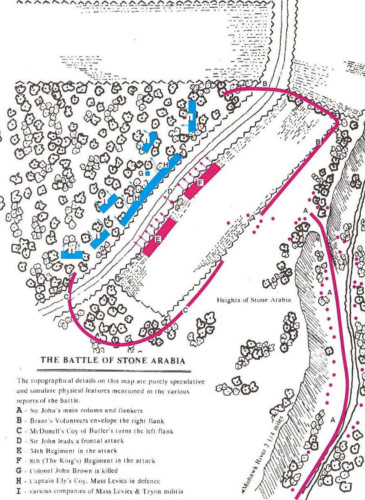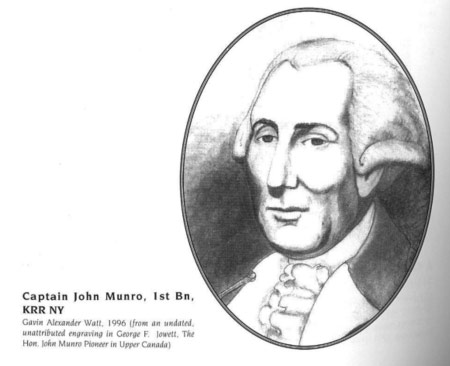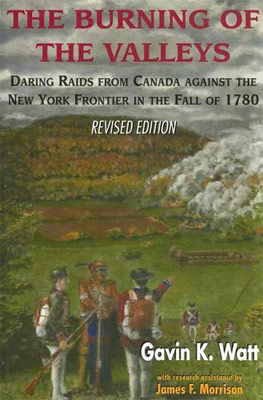The Burning of the Valleys
The Burning of the Valleys, Daring Raids from Canada Against the New York Frontier in the Fall of 1780 - REVISED EDITION.
by Gavin K. Watt.
with research assistance by James F. Morrison.
Buy from: Amazon.com | Amazon.ca | Amazon.co.uk | Globalgenealogy.com
In the fifth year of the War of Independence, while the Americans focused on the British thrust against the Carolinas, the Canadian Department waged a decisive campaign against the northern frontier of New York. Their primary target was the Mohawk River region, known to be the “grainbowl” that fed Washington‘s armies. The Burning of the Valleys details the actions of both sides in this exciting and incredibly effective British campaign.
General Frederick Haldimand of Canada possessed a potent force, formed by the deadly alliance of toughened, embittered Tories, who had abandoned their families and farms in New York and Pennsylvania to join the King‘s Provincial regiments in Canada, and the enraged Six Nations Iroquois, whose towns and farmlands had been utterly devastated by Continentals in 1779. The Governor augmented this highly motivated force with British and German regulars and Canadian Iroquois.
In October, without benefit of modern transportation, communications or navigational aids, four coordinated raids, each thoroughly examined in this book, penetrated deeply into American territory. The raiders fought skirmishes and battles, took hundreds of prisoners, burned forts, farms, and mills and destroyed one of the finest grain harvests in living memory.
392 pages. Softcover (perfectbound) 6 X 9. Illustrated, maps, comparative chronology, appendices, bibliography, endnotes, index.
Published by Dundurn, Toronto 1997
ISBN 0-55002-271-7
REVIEWS AND COMMENTS
Michael Aikey, Director, New York State Military Museum and Veterans Research Center, Saratoga Springs, NY (2013)
Come May I'm off on another adventure - retirement from the museum. Unknown to you, you have played a small role in charting my retirement adventure. After reading "Burning of the Valleys" I became interested in the 1780 Ballston raid. The first step is to physically find the indian trail the raiders used. That's a Spring project.
Harry Maher, Elk River, Minnesota – a Barnes & Noble review
"If the lover of history is looking for a detailed (almost day-by- day) history of the American Revolution in upper New York’s Mohawk Valley, he cannot go wrong with Gavin Watt’s four books: (1) The Rebellion In The Mohawk Valley, The St. Leger Expedition of 1777, (2) The Burning of the Valleys, (3) A Dirty, Trifling Piece of Business, and (4) I Am Heartily Ashamed. A Canadian himself, Gavin Watt still delivers a balanced work, presenting the view from loyalist, native, and rebel perspectives. The terror of imminent attack and the tedium of the decimating winters of the northern valleys are felt. When one’s ancestral roots are in the Mohawk and nearby valleys, these books strike close to home even when one is personally far away. I loved every page, and I heartily recommend these books and look forward to new works by this author."
Mary Messere, ”Fort Klock: A timeless piece of American History” 19 January, 2012
from http://historystarproductions.com/blog/fort-klock-a-timeless-piece-of-american-history/
Fort Klock, was built on a hill overlooking the Mohawk River and just above the King’s Highway (now the railroad bed). For protection against raiding Indians it contained “loop holes” so that it could be fortified by long rifle from within its walls during raids. It served as protection for other settlers in the area during these times. Its formidable stonewalls that are two feet thick could ward off munitions as well as fire.
The story of the many raids that took place from Canada are featured in the book “The Burning of the Valley” by Gavin K.Watt”, a wonderfully researched book with a story and maps of the famous “Burning of the Harvest at Klock’s Field”. Humorously, the book gives us the view from the British–Canadian raiders side. So few of us realize that many of the Mohawk Valley settlers who remained loyal to the Crown had to flee to Canada, leaving their homes behind and that many of these settlers participated in these burning raids as retribution.
Reviewed by Chuck for Goodreads, 19 October, 2012
"The Burning of the Valleys" by Gavin K. Watt describes the coordinated Autumn 1780 attacks on New York State by three columns of English regulars and their loyalist and Native American allies. The attacks were designed to remove all of New York north and west of Albany from playing any further part in the American Revolutionary War. And in that, they were fairly successful.
Gavin K. Watt is a Canadian historian noted for his expertise on and passion for the history of the Lake Champlain, Lake George, and Mohawk River Valleys. He has written a number of excellent books on the History of the American Revolution in those regions. A Canadian, he provides a well thought-out and reasoned view-point that occasionally seems a bit revisionist to this United States reader. His books are well written and excellently sourced with original documents. This region and its history is clearly a life-long love for him
The book itself covers the British Autumn 1780 attack on the region. The attack consisted of three columns composed of English Regulars, supplemented with Loyalist and Naive American allies. The columns basically moved at will, destroying Patriot fortifications, settlements and harvests. Because the columns were light and fast moving, the Patriots generally were unable to respond quickly and mass sufficient military power to oppose the invading forces. It wasn't until the very end of the campaign that the Patriots brought up sufficient militia to attack the English column in the Mohawk valley. By that point the English column had already pretty much burned everything to the ground and was returning home. The responding militia had all of the problems that any newly formed and deployed unit experiences. In the end, the militia was unable to successfully close and destroy the retiring English.
I would recommend this book for anyone interested in the military history, particularly of the American Revolutionary War period. Additionally, the book would be of interest to those who are curious about the problems faced by a militia army when facing regulars.”
Jay Young, “Family Ties: The Successes and Challenges of Genealogical Research” in Active History.ca, 17 October, 2011.
I have read history books about the different locations and time periods to better understand the wider picture about the times of the generations before me. It is one thing to read a book like The Burning of the Valleys (1997) by Gavin K. Watt to learn about the American Revolution, and a totally different experience to find out that the name of a relative who fought with the British forces in the Butler’s Rangers was a key player in the book.
John P. Dumville, Historic Sites Operations Chief, State of Vermont (2006)
I wish I had known you were at Hubbardton for the annual encampment on July 8-9. I would have liked to have to meet you. I live in Royalton and have been telling people in the area they should get a copy of your book… to get a good summary on the 1780 Royalton Raid which puts it into the greater context.
C. Hofmann, King’s Rangers (2003)
This is a must have book for an American Revolutionary War reenactor.
John Helmut Merz, “The Hessian,” Hamilton, ON. UEL Mailing List, Rootsweb (2000)
On the recommendation of one of my Quebec friends, who is also looking for truth in reporting of historical events, I ordered through interlibrary loan the book by Gavin K. Watt… “Burning of the Valleys.”
Now personally I don’t know Mr. Watt, never met him…, but I have to say that this book covers more ground and facts are presented more than in any other book dealing with this subject. The research which has gone into this book is unbelievable, a tremendous job by the author.
Philip D. Weaver, The Colonial Chronicle: A Newsletter of 18th & Early 19th Century North American Living History, Vol. 4, No. 3, 12. (Fall 1998)
Every so often there comes along a book that you wish you had written. This one is a living historian’s dream! Filled with the minutia we all love, this book incorporates rosters, casualty reports, 88 pages of notes and appendices, custom maps, photographs of recreated soldiers and civilians, contemporary illustrations, and modern drawings into a well-organized collection. Following the preface is a chronology of some of the primary events of the American Revolution and key occurrences relating to the New York frontier and Canada. The individually sourced biographies of the key personalities of the period serve as an introduction to the body of the work, and prove to be very enlightening.
Mr. Watt, best known as the founder of the recreated King’s Royal Yorkers, has also included a comparative chronology of the details of the October, 1780 raids. This little two page summary subtly reminds us that these historical events happened simultaneously.
Anyone interested in the role of New York, Canada, the Loyalists, the Iroquois Indians, the British Army, the Colonial militia, the Sullivan-Clinton Campaign, the Mohawk and Schoharie Valleys, or Lake Champlain in the Revolution will find this book a most welcome addition to their library.
Canadian Military History Book Review Supplement (1998)
Watt (with research assistance from James F. Morrison) has dug out a wealth of information about the raids, which enables him to describe them in exhaustive detail. This is no mean feat, as anyone who has worked with these documents knows…. But Watt is up to the task, for his descriptions of the raids are clear, concise, and easy to follow.
As a work of microhistory, the book is at its weakest when it considers the big picture…. There is considerably more scope for analysis. This criticism is not meant to detract from the book’s importance, however. It has given us what will probably be the definitive accounts of these most interesting operations.
 Todd Espinoza, Milford, NH (1998)
Todd Espinoza, Milford, NH (1998)
A Fantastic work and a pleasure to read the History of a forgotten area of history, the American Revolution as it happened in New York State. Very well documented, good selection of paintings, modern photographs and maps of the region. The indices are unquestionably the most complete that I have ever seen.
Jay Young, “Family Ties: The Successes and Challenges of Genealogical Research” in Active History.ca, 17 October, 2011.
Watt's account of that failed campaign is thorough, perceptive, and painstakingly documented. The narrative is immensely detailed and buttressed by numerous lengthy reference notes. Watt frequently shifts the scene and time as he follows the campaign and American responses to it, conflicts in Tryon County between Loyalists and whigs, and the activities of badly divided Native peoples. He also interjects descriptions of the character, roles, and even personal tragedies of leaders in all these groups. The reader will need to persist, but will find Watt's account well worth the effort. He assists the reader with maps and a 'comparative chronology,' as well as a substantial index. This book, 'twenty-five years in the making' according to the author, will be the definitive account of the St Leger expedition.
Jennie Mould email (2004)
James Elliott, The Hamilton Spectator (1997)
There’s a book in here somewhere. I’m convinced of it. New York’s nasty civil war (elsewhere known as the American Revolution) is certainly deserving of one, but the ungainly format of this publication almost guarantees a very limited audience. Sandwiched between 65 pages of introduction and background at the beginning and 122 pages of notes, appendices, bibliography and index at the end, is a good, solid read.
Anyway, author/re-enactor Gavin Watt has amassed a ton of documentation – that’s good, no question he’s done his homework and the some – but readers may wonder if he needed to share it all with them.
Watt writes with wit and undeniable passion but there’s simply too much raw data here.
Whether your bloodline includes an ancestor that marched with the Tryon County militia or a similar counterpart on the other side or not, you will find much in way of valuable source material here – provided you persevere.
Ontario Historical Society Bulletin (1997)
A study of four incursions from Canada into New York in the fifth year of the American Revolution – their historical significance is still debated. They may not have determined the outcome of the war, but they were militarily highly successful. As the constant use of loyalist and rebel in the text makes it clear, Gavin Watt is a passionate Canadian, but he testifies to his deep dependence on the research of an American colleague. Military historians have a love for detail, especially those who (like this author) enjoy taking part in re-enactments of battles as human dramas.
Dennis P. Farmer, Batavia, NY, Ontario History (1997)
Mr. Watt notes from the start that a distinct Canadian perspective will be presented, displaying a Loyalist point of view often lacking in nineteenth- and early twentieth-century American accounts. [The book] also provides a certain balance often lacking in earlier material… where Sir John Johnson’s personal courage is questioned without supporting evidence and the amount of space given to his efforts and those of his enduring Royalist raiders is both limited and belittling.
Chronology is vastly aided by an assortment of tables and calendars, which allows the often confusing flow of events to be placed in its proper orbit. Not as useful, while still well done, are the contemporary photographs and art works used in illustration. Perhaps this effort could have been more effective if period graphics had been used more fully. The maps are excellent, with careful research notes providing the user with a clear understanding of fact and conjecture dealing with several important if minor battles.
A strong point [of this book] is the details of Provincial and First Nations tactics and logistics documented by the author. The organization of these minutiae could overwhelm the reader, but they are skillfully and succinctly added to the abundant and rich text.
 Murray Hogben, The Kingston Whig-Standard (1997)
Murray Hogben, The Kingston Whig-Standard (1997)
Taking a stoutly Canadian stand, Watts then lays out the evidence for arguing that the raids were remarkable and effective…. In many ways, Watts’ book is unusual, a kind of manual for battlefield buffs.
Stephen Gilbert, Military Collector & Historian, Vol.49, No.1, Company of Military Historians (1997)
The well-designed introduction is most useful, so too a chronology of primary events and a unique simultaneous comparative chronology of the four raids…. This is a quality history of a little-studied chapter of the Revolutionary War. It is also excellent local history: a well-documented collaborative effort dedicated to setting the story straight…. While from a definite Canadian perspective, his account is deftly balanced with both Loyalist and Rebel sources…. Watt’s honesty where faced with uncertain historical facts is refreshing. He is quick to point out where he exercises his own interpretation, and where disagreement remains among sources.
Nitpicks aside, this work is most highly recommended; one wishes that more detailed books of this caliber existed to cover other little-known chapters of the AWI.
Cataraqui Loyalist Town Crier, Kingston and District Branch, UEL Association of Canada (1997)
This absorbing volume describes the Loyalist raids which wreaked fear and havoc on the American frontier and made possible for many Loyalists a retreat into Canada. Retold in an easy, flowing style, The Burning of the Valleys is a fine gift for anyone interested in thorough historical research.
